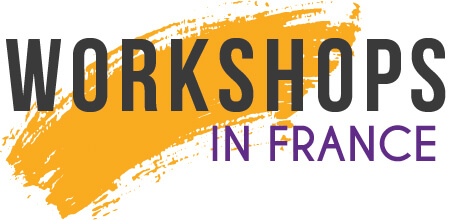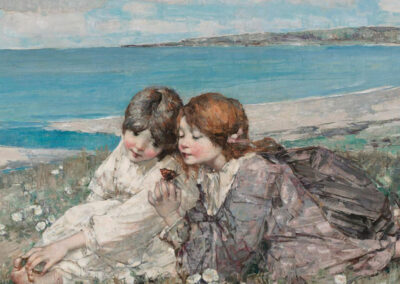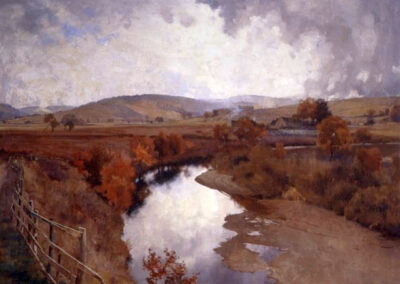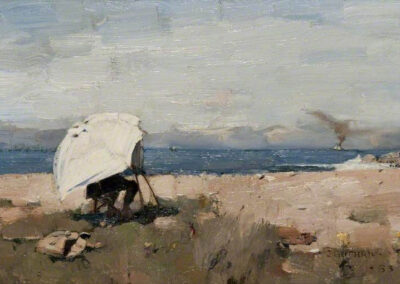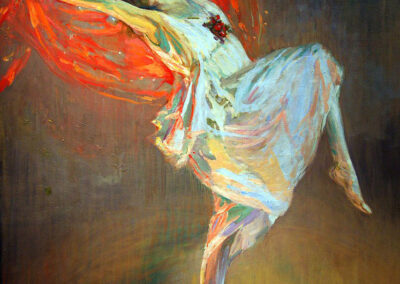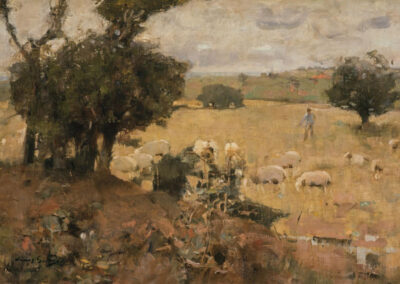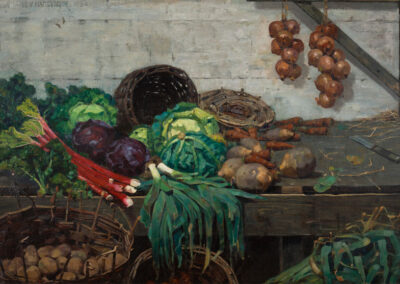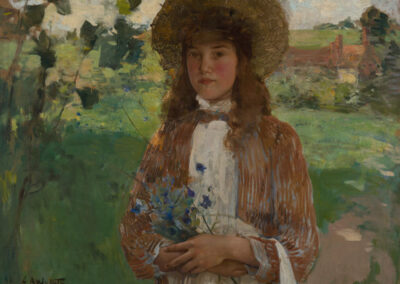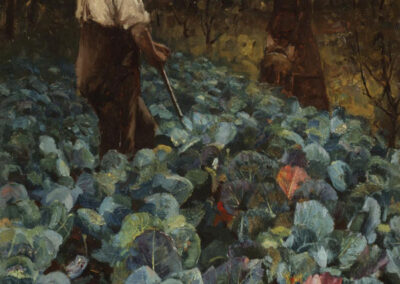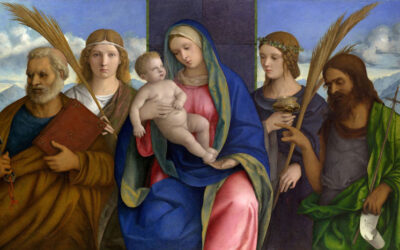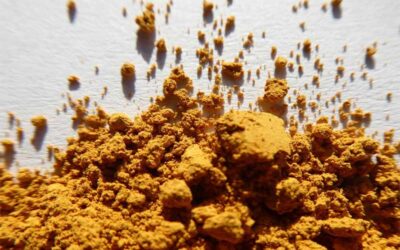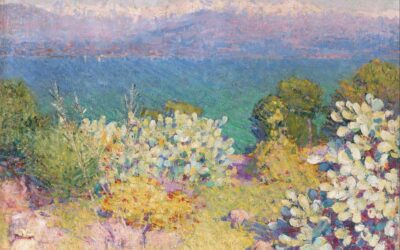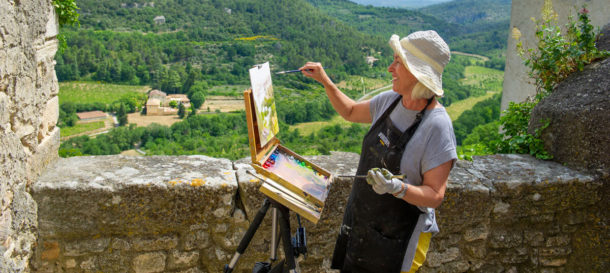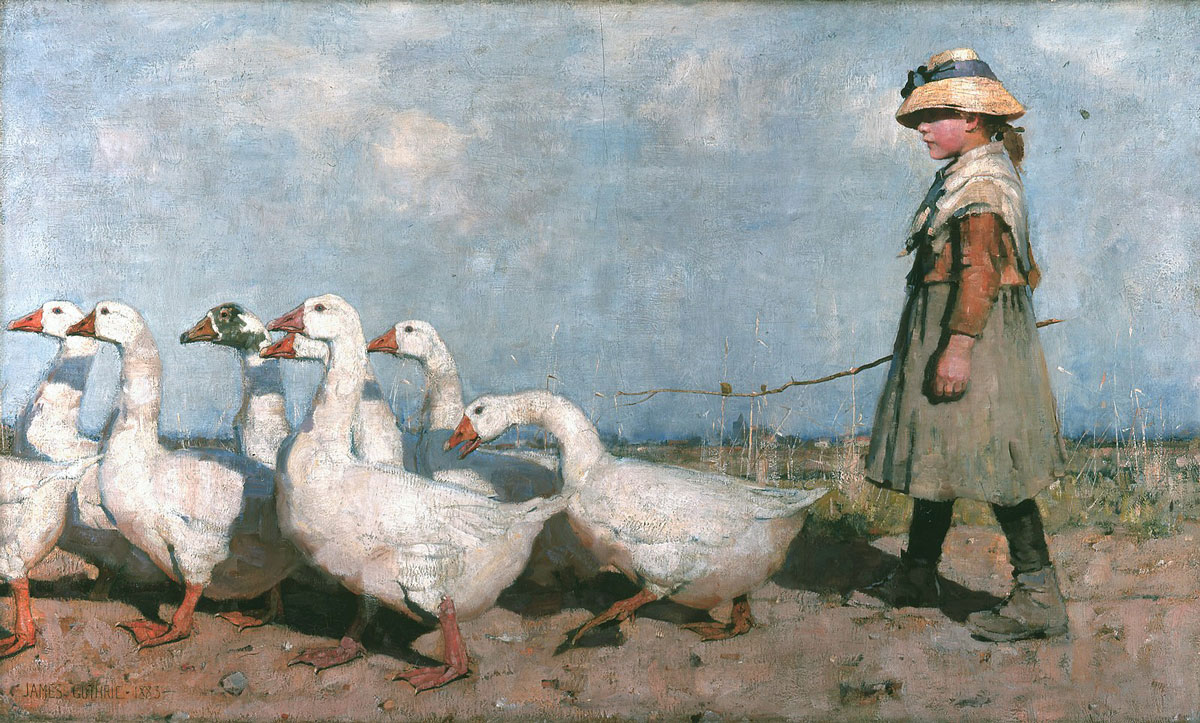
“To Pastures New”, Sir James Guthrie, 1883
Every time we explore a travel destination our lives become richer for the experience. That’s to be expected, after all, that’s why we are so motivated to organize these types of events. Sometimes the unexpected encounter is surprisingly inspiring, making the entire trip unforgettable.
So it was during a painting trip that Julie and a group of artists took to Scotland in 2010, that the Art Museum in Glasgow, the Kelvingrove Art Galleries, exhibited a collection of the work of the ‘Glasgow Boys’. This was the first comprehensive exhibition of the work of these late 19th-century painters. The show made a wonderful impression on the guest artists who viewed the collection, none of whom previously knew anything about Scottish art. Artwork by the Glasgow Boys continues to make an impact a century after these paintings were created back in the 1880s. They were painted in an act of rebellion against the art-elite status quo of their time.
Hello, art history buffs, we want to take you on a journey to Scotland and talk a little bit about a group of artists whose work you are sure to enjoy!
The Start of a Rebellion
Although they were not all from the city of Glasgow, and one wasn’t even Scottish for that matter, the Glasgow Boys were a group of artists who painted together in Scotland, and later abroad and who exhibited their work in Glasgow, thus the name, The Glasgow Boys. Their work, like other contemporaries around Europe, rejected traditional art styles and subjects and thrust the art scene into modernism. Like their counterparts on the Continent, these artists were ready to try something fresh and new when it came to painting. The Glasgow Boys were a group of around twenty painters who exhibited together in Glasgow. Some of the key members were James Guthrie, John Lavery, Joseph Crawhall, Edward Arthur Walton, James Paterson, Arthur Melville, George Henry, and E. A. Hornel.
They were seen as rebels by the art academics in Scotland. Their work was an effort to strike a blow against the kind of studio painting where art was done in the traditional academic style. They rejected the ideals of painting overly-romanticized Highland landscapes and portraits of the gentry. Instead, they painted to capture the everyday people, the farmlands, and the natural world of Scotland. The Glasgow Boys wanted to paint realistic scenes. This modernistic approach was not limited to Glasgow of course, as artists throughout Europe were rejecting academic Classicism for a more direct style, painting from observation and often en plein air. The transition eventually led to Impressionism.
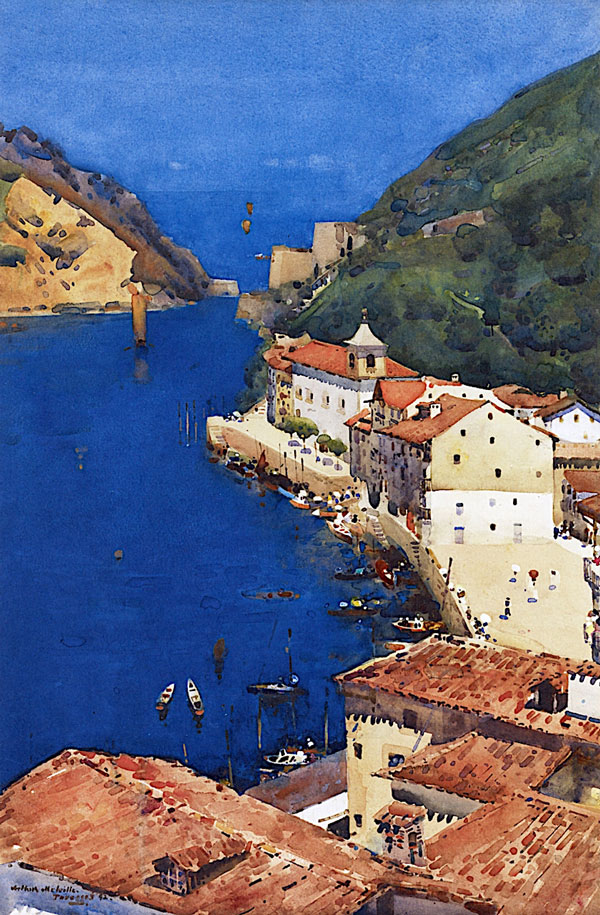
“The Sapphire Sea” Arthur Melville, Watercolor on Paper
The Glasgow Boys were not limited to painting around Glasgow, they traveled throughout Scotland, went to London and a few of the artists chose to develop their skills in France. There they saw the work of the Barbizon School artists, Gustave Courbet, and the deeply influential Jules Bastien-Lepage, the renowned French naturalist painter.
In the beginning, The Glasgow Boys often painted working-class people working the land or in their various trades. Later some of the group turned to painting the affluent middle class and their leisure pursuits such as tennis and croquet. As the individual artists of the Glasgow Boys developed their work, two of them, George Henry and Edward Hornel, moved to Kirkcudbright, a small Scottish town and there they adopted symbolism as their motif in painting, choosing to depict the ideas behind their subjects and the narratives rather than painting directly from observation. This was in part a direct response to the influence of Japan as it opened up to trade and the West was exposed to the Japanese style known as Japonaise. In fact, Henry and Hornel traveled together to Japan to discover firsthand the Japanese aesthetic later on in their careers.
Glasgow, City of Industry and Art
19th century Glasgow was a thriving city built on a tradition of international shipping even before the Industrial Revolution. Trading raw materials such as coal and woven woolens for sugar and tobacco with their counterparts in the New World and West Indies, created a class of well-to-do merchants. But during the industrial revolution, Glasgow’s shipbuilding and manufacturing pushed the city’s wealth into affluence.
Although Edinburgh was known as the “Athens of the North” being the cultural and academic center of Scotland, Glasgow’s art community was the driving force of innovation in the art world. Glasgow in the 1880s was booming and the wealthy were collecting European and Scottish art. The healthy economy made Glasgow the ideal location for artists’ studios. Scottish art collectors who traditionally sought out works from the Continent were also enamored with Scottish artists. Savvy businessmen and wealthy industrialists became collectors and patrons of these artists. One of the major collectors of the late 1800s was Sir William Burrell who purchased many works of art including those by Corot, Courbet, Degas, Fantin-Latour, Manet, and Millet. He was introduced to and became a patron of the Glasgow Boys through a Scottish art dealer.
However, back then the Glasgow Boys couldn’t get past the establishment’s selection committee for an opportunity to exhibit in the Glasgow Institute Exhibition because of their unconventional style. But over the course of 10 years, they would eventually dominate the Scottish art scene.
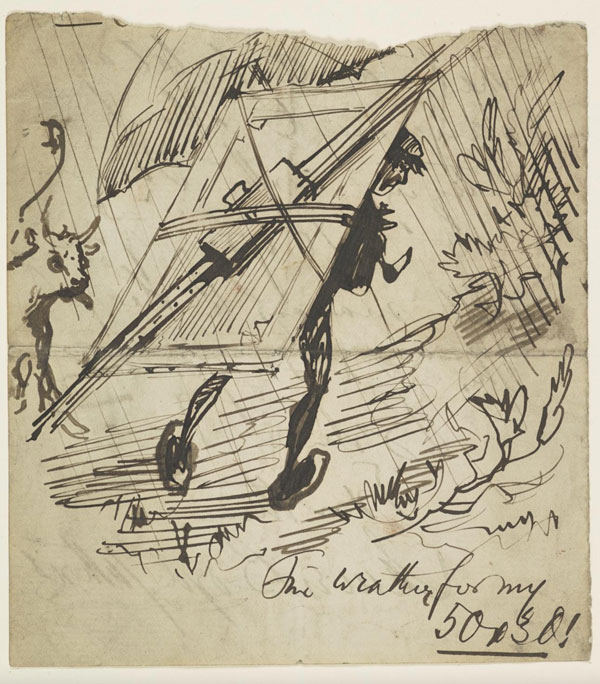
En Plein Air
Working individually and in groups, the artists left their studios to go paint in the open air. Their subject matter was well beyond the boundaries of the City of Glasgow. The Glasgow Boys traveled throughout Scotland and took to the countryside to paint the landscape as well as its people. In the sketch on the left, you can see a lighthearted drawing showing the plein air painters carrying their gear into the countryside.
Premixed oil paints were not entirely new but the Glasgow Boys were some of the first to use them out of doors. The artists explored how to paint in different ways. By painting from life they were able to paint their subjects directly instead of working in the studio or from memory. They painted with a sense of freedom that is apparent in their loose and impressionistic brushstrokes.
“Fine Weather for my 50×30”, Sir James Guthrie
Paris and Jules Bastien-Lepage
Some of the Glasgow Boys had traveled to Paris to study, John Lavery among them. Paris in the 1800s was considered the very epicenter of the art world, and this is where many painters learned their trade. Some of the Glasgow Boys attended the L’Académie Julian to learn more about painting. It was in Paris that John Lavery studied under Jules Bastien-Lepage. This enormously influential artist broke French tradition when he painted simple peasants in his home village. For example, when he painted “Les Foins” in 1877 he shocked the audience! Bastien-Lepage’s style of painting was still rooted in a traditional academic style, but his subject matter made his work unique. He was also aware of the innovative impressionism that was impacting the French scene, influencing his result that was both precise and yet loose.
John Lavery was enamored with Bastien-Lepage’s handling of paint and his choice of subject and he and the other Glasgow Boys followed his lead and created a considerable amount of work depicting Scottish peasants and pictures of real life. By the way, you can see his influence in the painting style adopted by the Glasgow Boys, and even his signature style, literally — just look at how Bastien-LePage, Guthrie and Paterson signed their paintings.
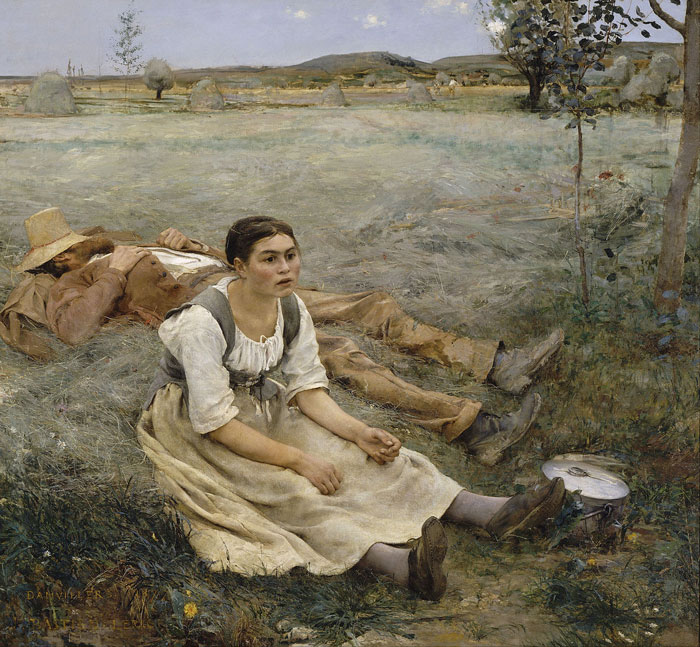
“Les Foins” or ‘Hay Making’ Jules Bastien-Lepage, 1877, Oil on Canvas,
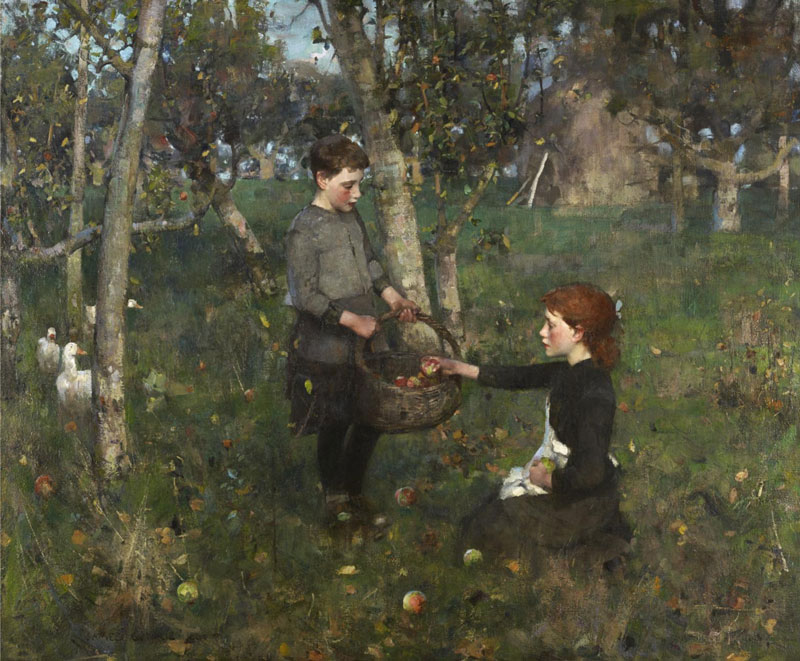
Left: “In the Orchard” by Sir James Guthrie, 1886, Oil on Canvas,
Right Top: “The Drake” Joseph Crawhall Scottish, 1895, Watercolor and Gouache on linen
Right Bottom: “A Hind’s Daughter”, James Guthrie, 1883, Oil on Canvas,
Pastoral Scenes
The Glasgow Boys were also interested in the work of realist painters Courbet and Millet who also focused on the poorer members of society. Inspired by this French Naturalism, the Glasgow Boys began producing a large number of pastoral scenes. They used a naturalistic style that captured both landscapes and people as they truly were.
In the painting on the bottom right, “A Hind’s Daughter” the tree in the background is painted with large rough strokes but it gives an impression of the tree, but at the same time as this loose style is used you can see the sensitive detail in the face of the young girl. Much like Jules Bastien-Lepage, they meshed both classic painting and impressionism styles to create realistic yet painterly works.
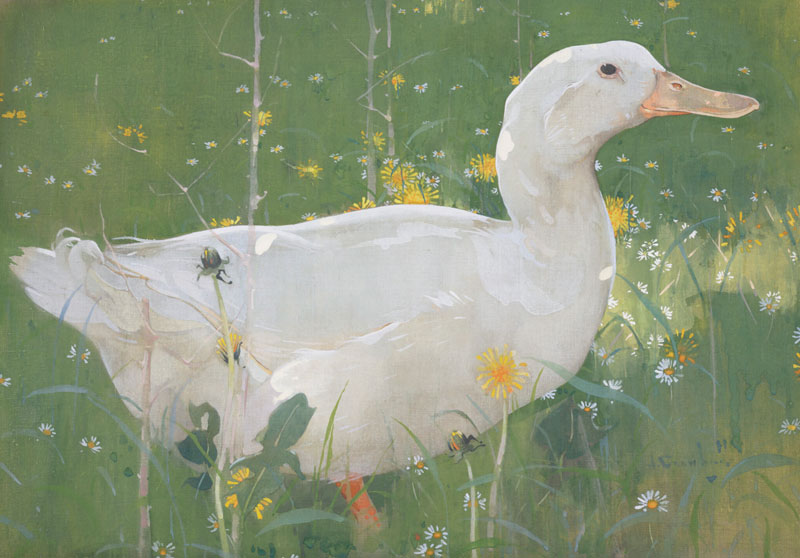
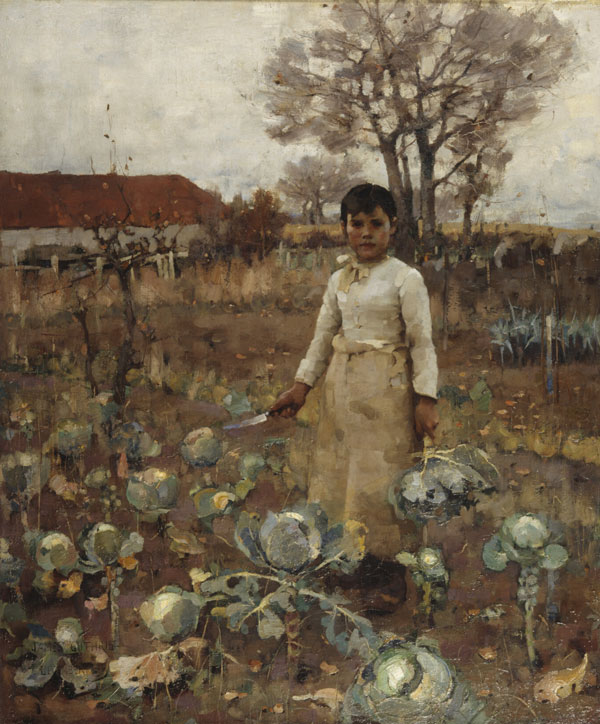
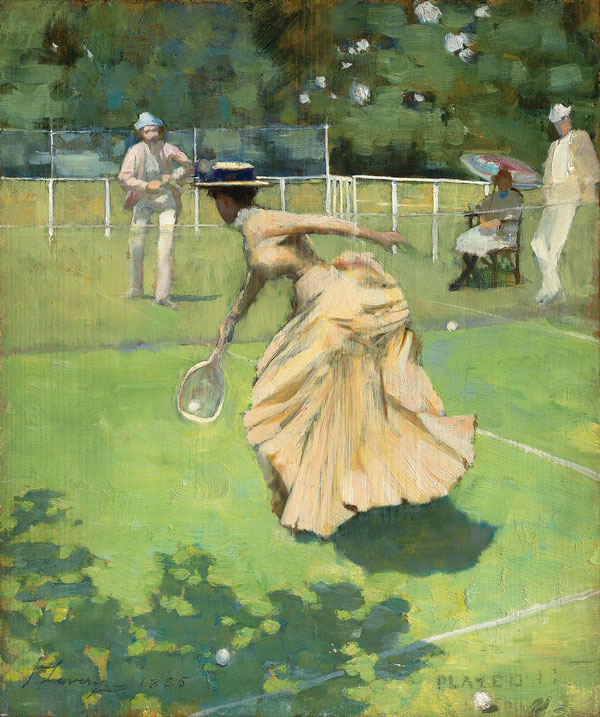
“Played!” Sir John Lavery, 1885
From Peasants to Players
Over time some of the Glasgow Boys became interested in subjects beyond simple rural life. John Lavery in particular, turned to the wealthy residents of Glasgow as painting subjects. Well-to-do Glaswegians had adopted the game of tennis played on private tennis courts on Glasgow’s south side.
The wealthy subjects of his paintings were interested in buying his work. With the financial and industrial success of Scotland, the growing middle class had money to spend on art. Many of these new patrons were eager to find something new, much like the Glasgow Boys themselves. John Lavery’s painting “The Tennis Party” won the gold medal at the Paris Salon.
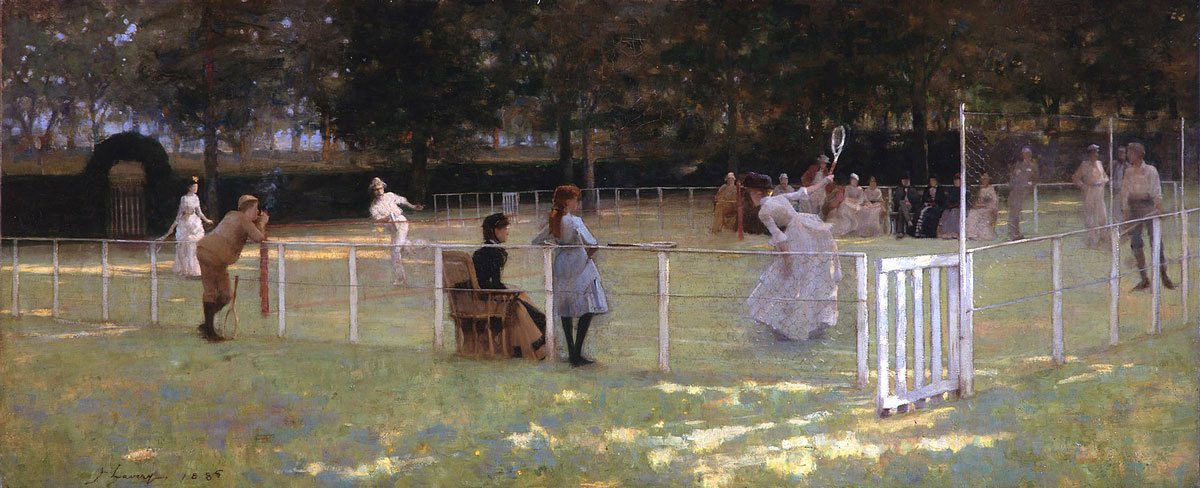
“The Tennis Party” Sir John Lavery, 1885
Hornel, Henry and Symbolism
The Glasgow Boys movement also included the works of George Henry and Edward Hornel. While they lived in the Scottish town, Kirkcudbright, they became interested in the Japanese style and as a result their art became more colorful and often symbolic. Hornel was especially interested in Scottish history, archeology and symbolism. Hornel would use designs from antiquity, like bronze age cups or stone carvings, to decorate his paintings. Their work was growing more and more symbolic and decorative. They wanted to paint what the landscape symbolized to them rather than a straight depiction of nature, and their work also included elements of their research. You can see the influence of the symbolism and their interest in the Japanese prints in the works below.
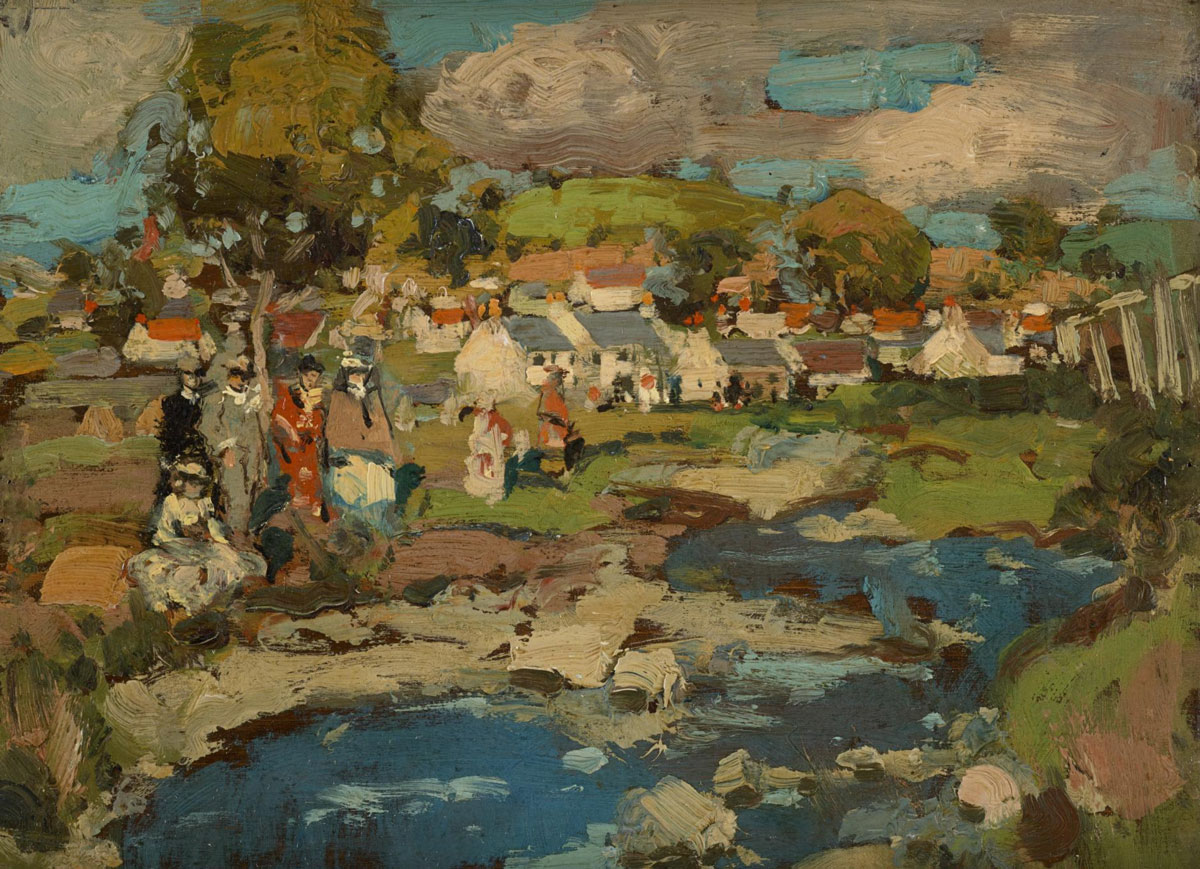
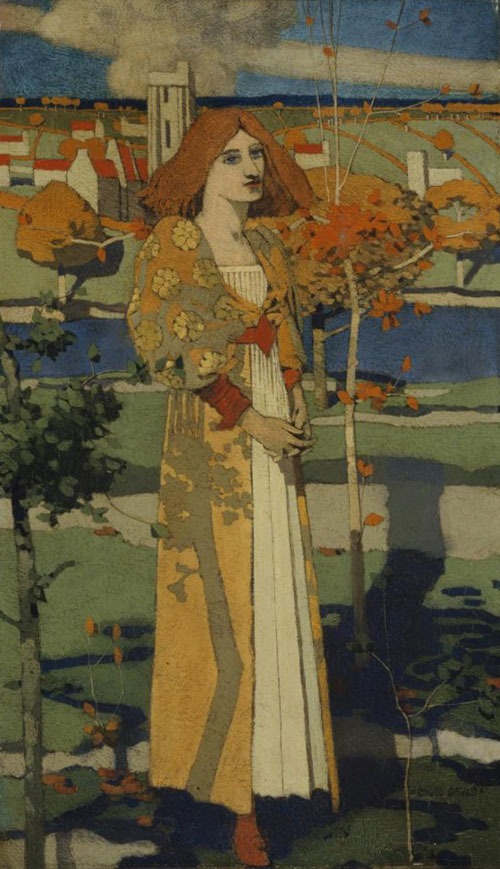
Top Left: “Barr Aryshire” George Henry, 1891, Oil on Panel
Bottom Left: “Saint Agnes” David Gauld, 1889-1890, Oil on Canvas
Right: “Geisha Girl” George Henry, 1894, Oil on Canvas

Druids Bringing in the Mistletoe
These two may have even provided influence for some of the very recognizable and decorative works of Gustav Klimt. In 1890, George Henry and A.E. Hornel worked together to paint the highly acclaimed painting “Druids Bringing in the Mistletoe ”. This work of art features a very high horizon line, flattened forms, and a decorative composition. It also features gold leaf which at the time was an unusual and innovative addition to the painting.
This painting traveled across Europe and was well received and even considered radical in Munich, Germany. The painting is loaded with symbolism, from the choice of the mistletoe which was used by druids for its apparent mystical and medicinal properties, to the inclusion of the golden sickle and the white sacrificial bulls. The painting is a definitive example of the thoughtful research and symbolic work of these two artists.
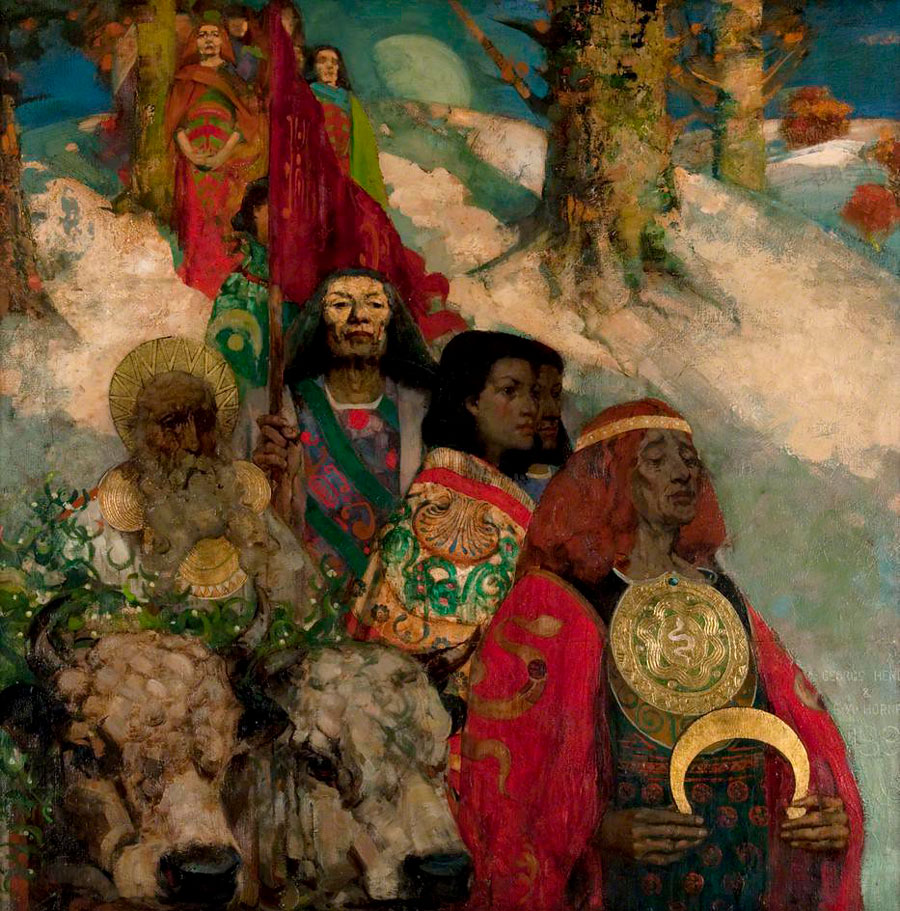
Right: “Druids Bringing in the Mistletoe” George Henry and E. A. Hornel
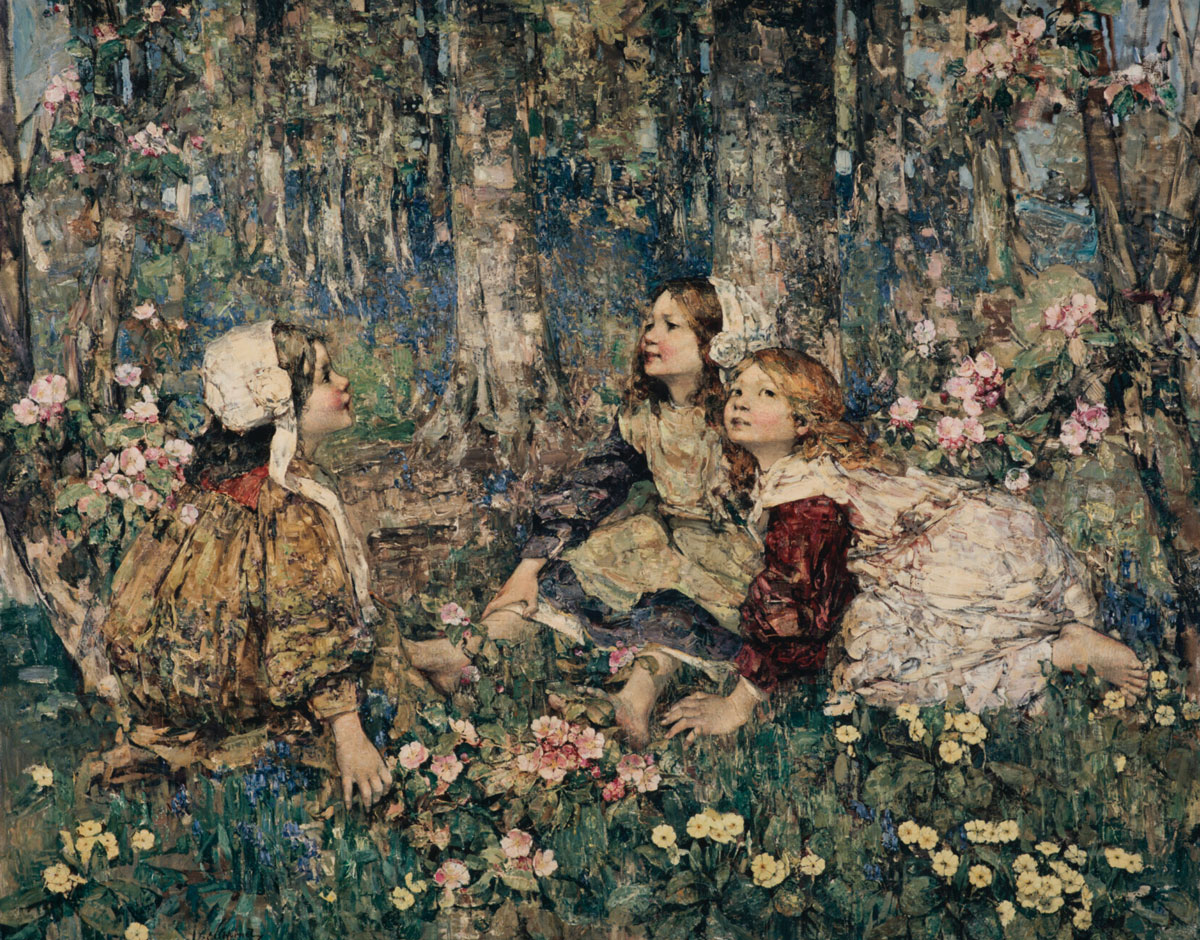
“The Music of the Woods” Edward Hornel 1906, Oil on Canvas
Paving the Way for Modernism
The Glasgow Boys produced a sizable collection of artwork and with their expressive brushstrokes and choice of subjects, they contributed to modernism. Nowadays, historians also recognize another group of artists from Scotland whom they call “The Glasgow Girls”. These women artists were working mainly in the decorative arts, they were highly innovative and hugely influential in Scotland and beyond and they too have also been acknowledged as contributors to the modernism movement.
We will just have to fully investigate their work and write another blog to do them justice.
Blogger: Lauren Carlo
Lauren Carlo is an artist and also the Marketing Director of Workshops In France. She lives in Baltimore, MD, and enjoys traveling, dancing, and rock climbing. You can learn more about her painting on her website or follow her on Instagram: @lauren.carloart.
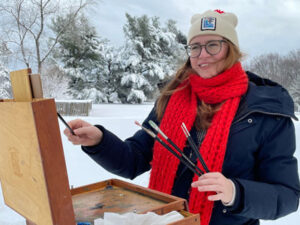
Your Artist Getaway Awaits
Check out more blogs about art workshops, tips and hacks for artists traveling in France and Scotland.
Les Carrières des Lumières Explores Venice 2022
This year at Les Carrières des Lumières, the famous underground quarry is once again transformed into a theater of mind-blowing proportions through the wizardry of technology, showing projected masterworks from Venice as well as the work of Yves Klein in Infinite Blue onto its limestone walls.
Yellow Ochre Lifted from Nature’s Palette
Yellow ochre is a naturally mined pigment used by artists everywhere. One of the must-see villages in Provence is Rousillon, where this multi-hued pigment was mined. You see it as orange, pink, and red on the walls of all houses and the red rock faces for the surrounding hills.
Discovering John Peter Russell: The Lost Impressionist
Why is it that John Peter Russell is known as Australia’s lost Impressionist? Despite being a gifted painter who landed in Paris at the center of the Impressionist movement today he remains virtually unknown. He was well connected with friends like Monet, Van Gogh, Rodin and more
